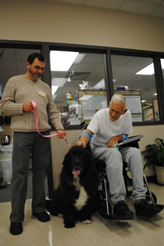Editorial
Front Page - Friday, January 7, 2011
Therapy dogs provide a special kind of healing, connection to patients
Erica Tuggle
 Ronald Ramsey, a patient at Siskin Rehabilitation Hospital, enjoys a visit from Molly, a therapy dog, and her owner, Rick Hall. Therapy dogs like Molly visit Siskin and T.C. Thompson’s Children’s Hospital once a month and bring smiles and assistance to the patients in their therapy and rehabilitation.
- Erica Tuggle
Ronald Ramsey, a patient at Siskin Rehabilitation Hospital, enjoys a visit from Molly, a therapy dog, and her owner, Rick Hall. Therapy dogs like Molly visit Siskin and T.C. Thompson’s Children’s Hospital once a month and bring smiles and assistance to the patients in their therapy and rehabilitation.
- Erica Tuggle
It takes a special dog to be a therapy dog, says Lisa Morgan, the coordinator of the department of recreational therapy at Siskin Rehabilitation hospital and the head of the pet therapy program at Siskin and T.C. Thompson Children’s Hospital.
The work of therapy dogs produces profound results as these animals come into the hospitals and walk from patient to patient, offering up all their services. This leads patients to respond to the animals by incorporating the animal in their therapy and healing process, enjoying their non-judgmental and peaceful presence and remembering their own beloved pets through these visitors.
One of these special and
devoted therapy dogs is Molly,
a shaggy black-coated New-foundland breed, who is brought to Siskin and T.C. Thompson once a month by owners and therapy volunteers Rick and Sandy Hall. In addition to standard obedience skills, Molly has been trained for water rescue and drafting, in which she pulls a cart through a series of obstacles. Through this, she has developed good command skills and was better prepared for the testing required to become a therapy dog.
Any aggression shown by an animal means they won’t pass the test, Morgan says. They have to be able to handle the stress of test time, and if they are showing signs of not liking it, then it’s not fair to the animal to have them in the program, she says. Morgan says another thing the animals need to have is a positive response to hospital smells such as medicine and wounds.
Last Christmas Eve, the Halls began preparing Molly for one of the bi-annual tests to be a therapy dog. During the test, objects were dropped behind her, there were loud noises, IV towers were pushed alongside her, she walked with other dogs in a line, had her medical history checked and was handled to see her reaction. Molly passed with flying colors and is a natural in making people feel better, Morgan says. Sandy says that the hardest thing for Molly to control is her desire to give everyone big kisses.
Everyone benefits from a therapy dog visit from the owner to the dog to the patient. Lots of patients see the dog and are able to talk about their dogs they have had, share their memories of pets, open up and socialize with the volunteers and staff, Morgan says.
At T.C. Thompson, the dogs actually go into patient rooms to interact with the children.
“You can see the changes in people when the animals come in. I have had kids that couldn’t wait for the visit, and we could get them to work in therapy when the dogs were around,” she says.
At Siskin, patients manipulate the collars of the animals, brush them and reach out toward them as a goal instead of a stationary object like cones or a bench. This uses and helps to restore cognitive and manipulative skills as well as provides a more tangible motivation.
“It’s motivating in having an animal obey a command and not be judged in the progress by an animal,” Morgan says. “We had a patient spend an hour getting a collar on and off and then broke down in tears because he was so happy he did it.”
The patients can improve their tactile feel by just petting the therapy dog or can be helped in speech therapy when the animal obeys a command that a patient works to say. These animals can also help in grief therapy if a patient has lost an animal but is able to enjoy a visit from a dog that reminds them of their own.
The Halls say they can see the progress in people’s expressions, especially in the children they visit at T.C. Thompson that are able to take their mind off a treatment when Molly comes in to give them kisses after a rough day. Hall says Molly is always excited to visit the patients and returns to the car afterwards with reluctance.
The therapy dog program started in 1991 and now has about 50 dogs involved. Anywhere from one to five dogs visit the hospitals a day, and Siskin also allows patients to visit their own pets in the lobby.
Morgan says these visits can help patients lower their blood pressure; make them laugh with the funny things the animals do; and help patients exercise to aid their recovery. These animals will listen when people may not, can sense when someone is not feeling well, provide a sense of security and comfort and make life more interesting with their companionship, she says.
Looking into Molly’s big brown eyes and at her wagging tail, it seems she knows and enjoys being one of the special dogs that provide this unconditional love
to everyone they meet.
|
|